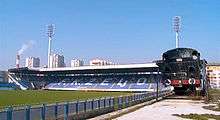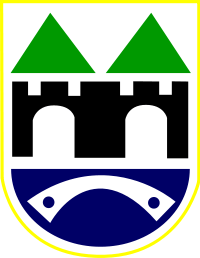Stadion Grbavica
| Valley of Cups | |
|
| |
| Location | Ulica Zvornička 21, Grbavica, Sarajevo, Bosnia and Herzegovina |
|---|---|
| Coordinates | 43°50′48″N 18°23′14″E / 43.84667°N 18.38722°ECoordinates: 43°50′48″N 18°23′14″E / 43.84667°N 18.38722°E |
| Owner | FK Željezničar Sarajevo |
| Capacity | 12.000 (9135 seated: north stand 5377, south stand 3068, west stand 690)[1] |
| Field size | 105 x 66 m (114.8 x 72.2 yd) |
| Surface | Grass |
| Construction | |
| Built | 1949–53 |
| Opened | 13 September 1953 |
| Renovated | 25 April 1976 |
| Expanded | 1986 |
| Tenants | |
| FK Željezničar Sarajevo (1953-1968, 1976-present) | |
Grbavica Stadium is located in Grbavica, Sarajevo, Bosnia and Herzegovina. The football stadium has terraces close to the pitch and it is the home of FK Željezničar. The stadium has a capacity to hold about 16,100 spectators, with officially 8,898 (to be expanded to 11,995 in 2016) places that are seated. It is also known as the Dolina Ćupova "Valley of Cups".
Construction
The building of the football ground in Grbavica started during the late 1940s by SD Željezničar. Although there were several football pitches with bleachers and stands in Sarajevo at the time (including the freshly built Koševo Stadium), it was decided by communist authorities that Željezničar should have its own playing facility. Many of the club's supporters, friends, and members, including a number Yugoslav People's Army personnel helped in the construction of the stadium. Unlike Koševo that was a large-scale project with generous state support through funds and manpower, Grbavica had a lot fewer people working on it and as a result took much longer to complete. A new pitch with a drainage system was built and the stands were built with concrete. The south and east side were made out of concrete, while wooden stands that were taken from the Marijin Dvor ground that was torn down, got placed on the west side. At first, Grbavica was a multi-use stadium. Competitions in cycling and athletics were organized, as well as football matches. Eventually its use became football only. It was officially opened on September 13, 1953 with the Yugoslav Second League western division match between Željezničar and Šibenik. Željezničar won 4-1.
1970s renovations

In 1968 renovations on the stadium began and on April 25, 1976 Grbavica was re-opened. About 50,000 cubic meters of materials were used, and the floodlights were installed. Two training pitches and the "little sports stadium" were added, as well as new dressing rooms, showers and other important facilities. The Đurasović family were the first donors.
1986: Northern stand added
In 1986 a proper northern stand was finally built. There were plans for the whole stadium to be remodeled and encircled to look like the newly built north stand, but they got shelved for the time being. As a result of the renovations, in October 1987, Yugoslav national football team (coached at the time by Željo legend Ivica Osim) played its first ever match at the stadium. In a Euro 88 qualification clash versus Northern Ireland, Yugoslavia won 3-0.
The stadium suffered heavy structural damage during the Bosnian War that broke out in 1992. The stadium was located between the first front lines and endured heavy fighting. Bosnian Serbs' forces burned the wooden terraces. It was not until 1996 that a football match would be played here again. Symbolically, the first match after the war was the local derby.
After the Bosnian War

It was partly remodelled in following years. In 2004, 8898 seats were installed on the north and south stand and some small work was done to the terraces. The last major job done on the stadium was in 2008–09 when the floodlights were repaired. On 22 April 2009, after about 18 years, a game under floodlights was again played on Grbavica. There are new proposals for a major overhaul of the current facilities. The new project proposes the creation of new roofed terraces on each side, and the increase of the capacity to 24,000 seated places. Other facilities such as a training ground near the stadium are proposed. These new proposals are still waiting financial backing.
On Monday, 13 February 2012, a section of the roof above the west stand collapsed after 10 days of heavy snowfall that buried the whole city of Sarajevo under more than a meter of snow setting a new record of height of snow in the city, causing a natural catastrophe, halting all of the public transportation for at least 3 days and causing widespread road and other types of blocking in the country and the city, resulting in many damages on buildings (like collapsing roofs and similar) and financial losses. The roof of the ice hall at the Skenderija sport complex also collapsed just a day before, just as the balloon covering the Zetra Ice Rink track near the Olympic Hall Zetra, which collapsed couple of days before. The weight on a square meter of surface was about 160 kg, while, for example, the supporting weight of the ice hall was about 100 kg per square meter. The main reason stated for the collapsing of the roof (and also the roof of the ice hall) was the bad maintenance of the whole terrace and roof were the snow was not removed since the first snowfall, but also the war damages on the buildings.
2016 Renovations
East stands to be built
It was announced the stadium east stands will be expanded as will South stands by end of 2017. Club plans to play host to first two rounds of European qualifying UEFA competition at the stadium (since end of Bosnian War, the club has played all its international matches at Asim Ferhatović Hase Stadium). Additionally club administration plans to ensure stadium can host Bosnian national teams (non friendly games) by upgrade completion. The combination of the two upgrades are first steps towards the reconstruction of the stadium.[2][3] It is estimated the capacity of east stands will be 4650 seats.[4]
West stands
West stands will hold 690 seats upon its completion in May 2016.
North stands
The capacity of North stands has been increased to hold 5377 seats.[5]
South stands
A modern LED Display has been installed in the south stand. Capacity of seating is 3068.[6] Total capacity of stadium is 11,995 seated places.[7]
Location
The stadium is located in the Grbavica neighbourhood, under the Šanac Hill which was traversed by railway tracks. When the train was passing over the stadium, it would sound its horn to salute the crowd. Nowadays, the old railway is no longer in use. There are however trolleybuses that pass by the stadium and visitors are able to come to the stadium using other modes of public transportation as well. The tramway line is also very close near the Socijalno station, which is located 600 meters away from the stadium.
Notable matches
By far the most notable match played at the stadium was the 1984-85 UEFA Cup semifinal return leg on Wednesday, 24 April 1985 between Željezničar and Hungarian visitors Videoton FC from Székesfehérvár. Videoton brought a 1-3 advantage from the first leg, however, the home side fought valiantly in front of the racous home crowd of 27,000 fans[8] and was 2-0 ahead on goals by Edin Bahtić in the 5th and Edin Ćurić in the 62nd minute. Just a few minutes from the end, Željo still had a result that would see it take on mighty Real Madrid in the UEFA Cup final. However, disaster struck in the 87th minute when Videoton right back József Csuhay was left unmarked and scored a goal for 2-1 that took his team to the final and saw Željezničar's hopes dashed in the cruelest of fashions.
International matches
| Date | Result | Competition | ||
|---|---|---|---|---|
| 14 October 1987 | | 3–0 | | Euro 88 qualifying |
| 15 August 2001 | | 2–0 | | Friendly |
| 27 March 2002 | | 4–4 | | Friendly |
| 10 August 2010 | | 1–1 | | Friendly |
Club friendly matches
- As part of the 50th birthday celebration on 16 June 1971, FK Željezničar played Inter Milan. Final result was 3-3 (however location was Koševo Stadium).
- As part of the 55th birthday celebration for the FK Željezničar (and 90th birthday celebration for Arsenal) played at Stadion Grbavica on August 16, 1976, Željezničar pulled out a friendly 1-1 draw with Arsenal.[9][10]
- As part of the 80th birthday celebration for the FK Željezničar, on October 2, 2001, the team welcomed Bundesliga side Wolfsburg with goals scored by Muharemović and Nermin Fatić FK Zeljo won 2-0.[11]
- As part of the 90th birthday celebration for the FK Željezničar, on November 8, 2011 the team welcomed a full strength national football team of Bosnia and Herzegovina and played a friendly that finished 1-2 in favor of the visitors. The scorer for the national team was Vedad Ibišević with two goals. The lone scorer for FK Željezničar was Mirsad Bešlija.[12]

Gallery
- Sarajevo 19.3.1996 war
- Stadium Grbavica
 Stadium Grbavica
Stadium Grbavica The Maniacs
The Maniacs- Zeljeznicar graffiti stadium wall
- Club wall graffiti around stadium
See also
References
- ↑ http://www.worldstadiums.com/europe/countries/bosnia_herzegovina.shtml
- ↑ http://reprezentacija.ba/43287-foto-zeljo-pravi-novu-grabavicu-za-europske-i-utakmice-reprezentacije
- ↑ http://sportsport.ba/bh_fudbal/zapoceli-radovi-na-renoviranju-stadiona-fk-zeljeznicar/188935
- ↑ http://fkzeljeznicar.ba/foto-bageri-na-stadionu-grbavica/23013/
- ↑ http://scsport.ba/vijesti/grbavica-povecava-svoj-kapacitet-/111561
- ↑ http://fkzeljeznicar.ba/zapoceo-projekat-renoviranja-stadiona-grbavica/18327/
- ↑ http://fkzeljeznicar.ba/pocetak-izgradnje-istocne-tribine-stadiona-grbavica/19225/
- ↑ Željezničar je prije 60 godina dobio dom, svoju Grbavicu;klix.ba, 13 September 2013
- ↑ woolwicharsenal.co.uk. "Željezničar and Arsenal: 15 August 1976". woolwicharsenal.co.uk. Retrieved 2015-08-15.
- ↑ zeljeznicarfk.blogspot.co.uk. "Željezničar - Arsenal 1-1". zeljeznicarfk.blogspot.co.uk. Retrieved 2015-08-15.
- ↑ "Plavi vremeplov: Željezničar – Wolfsburg". fkzeljeznicar.ba. Retrieved 14 August 2015.
- ↑ scsport.ba (November 8, 2011). "Željo odlično sparingovao Zmajevima" (in Bosnian). scsport.ba. Retrieved 2011-11-08.
External links
| Wikimedia Commons has media related to Grbavica Stadium. |
